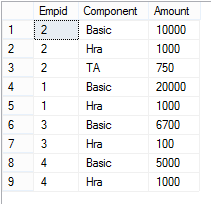Using PIVOT and JOIN Together in SQL Server
4.73/5 (12 votes)
Here we will see how to use PIVOT and JOIN together in SQL query
Introduction
When working with cross tab reporting, PIVOT is quite handy. But some time, we may need to use PIVOT and JOIN together. So here with a simple example, we would see how we can use these two things together.
Background
Let's say we have two tables where:
Employeemaster- Hold the basic information about employees:
Employeesalarydetails- Holds the salary structure details like basics and other others benefits (Transportation allowance, Overtimes, etc.).
Result- Now we want to create a query in a way that the result would be in the form of:
Tables And Data
Tables
/*create tables*/
CREATE TABLE Employeemaster(
Empid BIGINT,
EmpName VARCHAR(100)
)
CREATE TABLE Employeesalarydetails(
Empid BIGINT,
Component VARCHAR(100),
Amount FLOAT,
)
Data
/*insert datas*/
INSERT
INTO Employeemaster
VALUES (1, 'Emp1'),
(2, 'Emp2'),
(3, 'Emp3'),
(4, 'Emp4')
INSERT
INTO Employeesalarydetails
VALUES(2, 'Basic', 10000),
(2, 'Hra', 1000),
(2, 'TA', 750),
(1, 'Basic', 20000),
(1, 'Hra', 1000),
(3, 'Basic', 6700),
(3, 'Hra', 100),
(4, 'Basic', 5000),
(4, 'Hra', 1000)
PIVOT of Employeesalarydetails
The PIVOT of Employeesalarydetails is:
SELECT *
FROM Employeesalarydetails
PIVOT(
SUM(Amount)
FOR Component
IN([Basic],[Hra],[TA])
)AS DtlPivot

To start using PIVOT, check out http://www.codeproject.com/Tips/500811/Simple-Way-To-Use-Pivot-In-SQL-Query.
Now to get the required output, we only need to join Employeemaster table and this pivoted result.
JOIN Employeemaster and PIVOT-ed Result
Test live example http://www.sqlfiddle.com/#!3/ad5e6/2.
Using CTE
WITH Dtl
AS
(
SELECT *
FROM Employeesalarydetails
PIVOT(
SUM(Amount)
FOR Component
IN([Basic],[Hra],[TA]) -- pivot for [Basic],[Hra],[TA]
)AS DtlPivot
)
SELECT Emp.*,
COALESCE(Dtl.[Basic], 0) AS [Basic], -- assigning names for [Basic],[Hra],[TA]
COALESCE(Dtl.[Hra], 0) AS [Hra],
COALESCE(Dtl.[TA], 0) AS [TA]
FROM Employeemaster AS Emp
LEFT JOIN Dtl ON Emp.EmpId = Dtl.EmpId
To know more about CTE, check out http://www.codeproject.com/Articles/275645/CTE-In-SQL-Server.
Without CTE
SELECT Emp.*,
COALESCE(Dtl.[Basic], 0) AS [Basic], -- assigning names for [Basic],[Hra],[TA]
COALESCE(Dtl.[Hra], 0) AS [Hra],
COALESCE(Dtl.[TA], 0) AS [TA]
FROM Employeemaster AS Emp
LEFT JOIN
(
SELECT *
FROM Employeesalarydetails
PIVOT(
SUM(Amount)
FOR Component
IN([Basic],[Hra],[TA]) -- pivot for [Basic],[Hra],[TA]
)AS DtlPivot
)AS Dtl
ON Emp.EmpId = Dtl.EmpId
Find the necessary SQL in the attachment.
